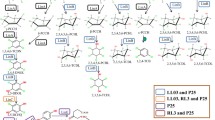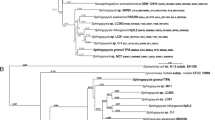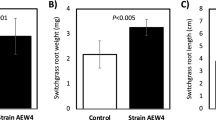Abstract
The study focuses on the in silico genomic characterization of Sphingobium indicum B90A, revealing a wealth of genes involved in stress response, carbon monoxide oxidation, β-carotene biosynthesis, heavy metal resistance, and aromatic compound degradation, suggesting its potential as a bioremediation agent. Furthermore, genomic adaptations among nine Sphingomonad strains were explored, highlighting shared core genes via pangenome analysis, including those related to the shikimate pathway and heavy metal resistance. The majority of genes associated with aromatic compound degradation, heavy metal resistance, and stress response were found within genomic islands across all strains. Sphingobium indicum UT26S exhibited the highest number of genomic islands, while Sphingopyxis alaskensis RB2256 had the maximum fraction of its genome covered by genomic islands. The distribution of lin genes varied among the strains, indicating diverse genetic responses to environmental pressures. Additionally, in silico evidence of horizontal gene transfer (HGT) between plasmids pSRL3 and pISP3 of the Sphingobium and Sphingomonas genera, respectively, has been provided. The manuscript offers novel insights into strain B90A, highlighting its role in horizontal gene transfer and refining evolutionary relationships among Sphingomonad strains. The discovery of stress response genes and the czcABCD operon emphasizes the potential of Sphingomonads in consortia development, supported by genomic island analysis.








Similar content being viewed by others
References
Jit S, Dadhwal M, Kumari H, **dal S, Kaur J, Lata P, Niharika N, Lal D, Garg N, Gupta SK, Sharma P (2011) Evaluation of hexachlorocyclohexane contamination from the last lindane production plant operating in India. Environ Sci Pollut Res Int 18:586–597. https://doi.org/10.1007/s11356-010-0401-4
Lal R, Pandey G, Sharma P, Kumari K, Malhotra S, Pandey R, Raina V, Kohler HP, Holliger C, Jackson C, Oakeshott JG (2010) The biochemistry of microbial degradation of hexachlorocyclohexane (HCH) and prospects for bioremediation. Microbiol Mol Biol Rev 74:58–80. https://doi.org/10.1128/MMBR.00029-09
Kumar J, D’Souza SF (2010) An optical microbial biosensor for detection of methyl parathion using Sphingomonas sp. immobilized on microplate as a reusable biocomponent. Biosens Bioelectron 26:1292–1296. https://doi.org/10.1016/j.bios.2010.07.016
Sutherland TD, Horne I, Weir KM, Coppin CW, Williams MR, Selleck M, Russell RJ, Oakeshott JG (2004) Enzymatic bioremediation: from enzyme discovery to applications. Clin Exp Pharmacol Physiol 31:817–821
Cao X, Yang C, Liu R, Li Q, Zhang W, Liu J et al (2013) Simultaneous degradation of organophosphate and organochlorine pesticides by Sphingobium japonicum UT26 with surface-displayed organophosphorus hydrolase. Biodegradation 24:295–303
Garg N, Lata P, Jit S, Sangwan N, Singh AK, Dwivedi V, Niharika N, Kaur J, Saxena A, Dua A, Nayyar N, Kohli P, Geueke B, Kunz P, Rentsch D, Holliger C, Kohler HP, Lal R (2016) Laboratory and field scale bioremediation of hexachlorocyclohexane (HCH) contaminated soils by means of bioaugmentation and biostimulation. Biodegradation 27:179–193. https://doi.org/10.1007/s10532-016-9765-6
Santillan JY, Rojas NL, Ghiringhelli PD, Nóbile ML, Lewkowicz ES, Iribarren AM (2020) Organophosphorus compounds biodegradation by novel bacterial isolates and their potential application in bioremediation of contaminated water. Biores Technol 317:124003
Verma H, Bajaj A, Kumar R, Kaur J, Anand S, Nayyar N, Puri A, Singh Y, Khurana JP, Lal R (2017) Genome organization of Sphingobium indicum B90A: an archetypal hexachlorocyclohexane (HCH) degrading genotype. Genome Biol Evol 9:2191–2197. https://doi.org/10.1093/gbe/evx133
Barton BM, Harding GP, Zuccarelli AJ (1995) A general method for detecting and sizing large plasmids. Anal Biochem 226:234–240. https://doi.org/10.1006/abio.1995.1220
Basta T, Keck A, Klein J, Stolz A (2004) Detection and characterization of conjugative degradative plasmids in xenobiotic-degrading Sphingomonas strains. J Bacteriol 186:3862–3872. https://doi.org/10.1128/JB.186.12.3862-3872.2004
Sayers EW, Bolton EE, Brister JR, Canese K, Chan J, Comeau DC, Connor R, Funk K, Kelly C, Kim S, Madej T, Marchler-Bauer A, Lanczycki C, Lathrop S, Lu Z, Thibaud-Nissen F, Murphy T, Phan L, Skripchenko Y, Tse T, Wang J, Williams R, Trawick BW, Pruitt KD, Sherry ST (2022) Database resources of the national center for biotechnology information. Nucl Acids Res 50(D1):D20–D26. https://doi.org/10.1093/nar/gkab1112
Pritchard L, Glover RH, Humphris S, Elphinstone JG, Toth IK (2016) Genomics and taxonomy in diagnostics for food security: soft-rotting enterobacterial plant pathogens. Anal Methods 8:12–24. https://doi.org/10.1039/C5AY02550H
Teeling H, Waldmann J, Lombardot T, Bauer M, Glöckner FO (2004) TETRA: a web-service and a stand-alone program for the analysis and comparison of tetranucleotide usage patterns in DNA sequences. BMC Bioinformatics 5:163. https://doi.org/10.1186/1471-2105-5-163
Teeling H, Meyerdierks A, Bauer M, Amann R, Glöckner FO (2004) Application of tetranucleotide frequencies for the assignment of genomic fragments. Environ Microbiol 6:938–947. https://doi.org/10.1111/j.1462-2920.2004.00624.x
Richter M, Rossello-Mora R (2009) Shifting the genomic gold standard for the prokaryotic species definition. Proc Natl Acad Sci USA 106:19126–19131. https://doi.org/10.1073/pnas.0906412106
R Core Team (2013). R: A language and environment for statistical computing. R Foundation for Statistical Computing, Vienna, Austria. http://www.R-project.org/.
Brettin T, Davis JJ, Disz T, Edwards RA, Gerdes S, Olsen GJ, Olson R, Overbeek R, Parrello B, Pusch GD, Shukla M, Thomason JA, Stevens R, Vonstein V, Wattam AR, **a F (2015) RASTtk: A modular and extensible implementation of the RAST algorithm for building custom annotation pipelines and annotating batches of genomes. Sci Rep 5:8365. https://doi.org/10.1038/srep08365
Tatusova T, DiCuccio M, Badretdin A, Chetvernin V, Nawrocki EP, Zaslavsky L, Lomsadze A, Pruitt KD, Borodovsky M, Ostell J (2016) NCBI prokaryotic genome annotation pipeline. Nucl Acids Res 44:6614–6624. https://doi.org/10.1093/nar/gkw569
Hyatt D, Chen GL, LoCascio PF, Land ML, Larimer FW, Hauser LJ (2010) Prodigal: prokaryotic gene recognition and translation initiation site identification. BMC Bioinformatics 11:1–11. https://doi.org/10.1186/1471-2105-11-119
Bray JR, Curtis JT (1957) An ordination of the upland forest communities of Southern Wisconsin. Ecol Monogr 27:325–349. https://doi.org/10.2307/1942268
Berrazeg M, Drissi M, Medjahed L, Rolain JM (2013) Hierarchical clustering as a rapid tool for surveillance of emerging antibiotic-resistance phenotypes in Klebsiella pneumoniae strains. J Med Microbiol 62:864–874. https://doi.org/10.1099/jmm.0.049437-0
Delcher AL, Kasif S, Fleischmann RD, Peterson J, White O, Salzberg SL (1999) Alignment of whole genomes. Nucl Acids Res 27:2369–2376. https://doi.org/10.1093/nar/27.11.2369
Darling AE, Mau B, Perna NT (2010) progressiveMauve: multiple genome alignment with gene gain, loss and rearrangement. PLoS ONE 5:e11147. https://doi.org/10.1371/journal.pone.0011147
Chen IM, Chu K, Palaniappan K, Ratner A, Huang J, Huntemann M, Hajek P, Ritter SJ, Webb C, Wu D, Varghese NJ (2022) The IMG/M data management and analysis system v. 7: content updates and new features. Nucl Acids Res 51(D1):D723–D732. https://doi.org/10.1093/nar/gkac976
Bertelli C, Gray KL et al (2022) Enabling genomic island prediction and comparison in multiple genomes to investigate bacterial evolution and outbreaks. Microb Genom. https://doi.org/10.1099/mgen.0.000818
Arndt D, Grant J, Marcu A, Sajed T, Pon A, Liang Y, Wishart DS (2016) PHASTER: a better, faster version of the PHAST phage search tool. Nucl Acids Res 44:W16–W21. https://doi.org/10.1093/nar/gkw387
Eren AM, Kiefl E, Shaiber A, Veseli I, Miller SE, Schechter MS, Fink I, Pan JN, Yousef M, Fogarty EC, Trigodet F (2021) Community-led, integrated, reproducible multi-omics with anvi’o. Nat Microbiol 6:3–6. https://doi.org/10.1038/s41564-020-00834-3
Contreras-Moreira B, Vinuesa P (2013) GET_HOMOLOGUES, a versatile software package for scalable and robust microbial pangenome analysis. Appl Environ Microbiol 79:7696–7701. https://doi.org/10.1128/AEM.02411-13
Murata K, Kawai S, Hashimoto W (2022) Bacteria with a mouth: discovery and new insights into cell surface structure and macromolecule transport. Proc Jpn Acad Ser B Phys Biol Sci 98:529–552. https://doi.org/10.2183/pjab.98.027
Maddocks SE, Oyston PC (2008) Structure and function of the LysR-type transcriptional regulator (LTTR) family proteins. Microbiology 154:3609–3623. https://doi.org/10.1099/mic.0.2008/022772-0
White DC, Sutton SD, Ringelberg DB (1995) The genus Sphingomonas: physiology and ecology. Curr Opin Biotechnol 7:301–306. https://doi.org/10.1016/s0958-1669(96)80034-6
Galperin MY, Nikolskaya AN, Koonin EV (2001) Novel domains of the prokaryotic two-component signal transduction systems. FEMS Microbiol Lett 203:11–21. https://doi.org/10.1111/j.1574-6968.2001.tb10814.x
Martin RG, Rosner JL (2001) The AraC transcriptional activators. Curr Opin Microbiol 4:132–137. https://doi.org/10.1016/s1369-5274(00)00178-8
Kaminska KH, Purta E, Hansen LH, Bujnicki JM, Vester B, Long KS (2010) Insights into the structure, function and evolution of the radical-SAM 23S rRNA methyltransferase Cfr that confers antibiotic resistance in bacteria. Nucleic Acids Res 38:1652–1663. https://doi.org/10.1093/nar/gkp1142
Procópio L, Alvarez VM, Jurelevicius DA, Hansen L, Sørensen SJ, Cardoso JS, Pádula M, Leitao AC, Seldin L, van Elsas JD (2012) Insight from the draft genome of Dietzia cinnamea P4 reveals mechanisms of survival in complex tropical soil habitats and biotechnology potential. Antonie Van Leeuwenhoek 101:289–302. https://doi.org/10.1007/s10482-011-9633-7
Kulajta C, Thumfart JO, Haid S, Daldal F, Koch HG (2006) Multistep assembly pathway of the cbb3-type cytochrome c oxidase complex. J Mol Biol 355:989–1004. https://doi.org/10.1016/j.jmb.2005.11.039
Preisig O, Zufferey R, Thöny-Meyer L, Appleby CA, Hennecke H (1996) A high-affinity cbb3-type cytochrome oxidase terminates the symbiosis specific respiratory chain of Bradyrhizobium japonicum. J Bacteriol 178:1532–1538. https://doi.org/10.1128/jb.178.6.1532-1538.1996
Sievert SM, Scott KM, Klotz MG, Chain PS, Hauser LJ, Hemp J, Hügler M, Land M, Lapidus A, Larimer FW, Lucas S, Malfatti SA, Meyer F, Paulsen IT, Ren Q, Simon J, Genomics Class USF (2008) The genome of the epsilonproteobacterial chemolithoautotroph Sulfurimonas dentrificans. Appl Environ Microbiol 74:1145–1156. https://doi.org/10.1128/AEM.01844-07
Fang FC (2004) Antimicrobial reactive oxygen and nitrogen species: concepts and controversies. Nat Rev Microbiol 2:820–832. https://doi.org/10.1038/nrmicro1004
Bessman MJ, Frick DN, O’Handley SF (1996) The MutT proteins or “Nudix” hydrolases, a family of versatile, widely distributed, “housecleaning” enzymes. J Biol Chem 271:25059–25062. https://doi.org/10.1074/jbc.271.41.25059
Balkwill DL, Fredrickson JK, Romine MF (2003) Sphingomonas and related genera. In: Dworkin M and others (eds.) The Prokaryotes: an evolving electronic resource for the microbiological community, Springer, New York, No. PNNL-SA-39356
Langille MG, Brinkman FS (2009) IslandViewer: an integrated interface for computational identification and visualization of genomic islands. Bioinformatics 25:664–665. https://doi.org/10.1093/bioinformatics/btp030
Borriss R, Rueckert C, Blom J, Bezuidt O, Reva O, Klenk HP (2011) Whole genome sequence comparisons in taxonomy. In: Methods in microbiology, Academic Press, pp. 409–436. https://doi.org/10.1016/B978-0-12-387730-7.00018-8
Ravenhall M, Škunca N, Lassalle F, Dessimoz C (2015) Inferring horizontal gene transfer. PLoS Comput Biol 11:e1004095. https://doi.org/10.1371/journal.pcbi.1004095
Dogra C, Raina V, Pal R, Suar M, Lal S, Gartemann KH, Holliger C, van der Meer JR, Lal R (2004) Organization of lin genes and IS6100 among different strains of hexachlorocyclohexane-degrading Sphingomonas paucimobilis: evidence for horizontal gene transfer. J Bacteriol 186:2225–2235. https://doi.org/10.1128/JB.186.8.2225-2235.2004
Verma H, Kumar R, Oldach P, Sangwan N, Khurana JP, Gilbert JA, Lal R (2014) Comparative genomic analysis of nine Sphingobium strains: insights into their evolution and hexachlorocyclohexane (HCH) degradation pathways. BMC Genomics 15:1014. https://doi.org/10.1186/1471-2164-15-1014
Tabata M, Ohtsubo Y, Ohhata S, Tsuda M, Nagata Y (2013) Complete genome sequence of the γ-hexachlorocyclohexane-degrading bacterium Sphingomonas sp. strain MM-1. Genome Announc 1:10–1128. https://doi.org/10.1128/genomeA.00247-13
Sheinman M, Arkhipova K, Arndt PF, Dutilh BE, Hermsen R, Massip F (2021) Identical sequences found in distant genomes reveal frequent horizontal transfer across the bacterial domain. Elife 10:e62719. https://doi.org/10.7554/eLife.62719
Hallee L, Khomtchouk BB (2023) Machine learning classifiers predict key genomic and evolutionary traits across the kingdoms of life. Sci Rep 13:2088. https://doi.org/10.1038/s41598-023-28965-7
Stolz A (2014) Degradative plasmids from sphingomonads. FEMS Microbiol Lett 350:9–19. https://doi.org/10.1111/1574-6968.12283
Sangwan N, Lata P, Dwivedi V, Singh A, Niharika N, Kaur J, Anand S, Malhotra J, **dal S, Nigam A, Lal D (2012) Comparative metagenomic analysis of soil microbial communities across three hexachlorocyclohexane contamination levels. PLoS ONE 7:e46219. https://doi.org/10.1371/journal.pone.0046219
Pearce SL, Oakeshott JG, Pandey G (2015) Insights into ongoing evolution of the hexachlorocyclohexane catabolic pathway from comparative genomics of ten Sphingomonadaceae strains. G3 (Bethesda) 5:1081–1094. https://doi.org/10.1534/g3.114.015933
Kim M, Oh HS, Park SC, Chun J (2014) Towards a taxonomic coherence between average nucleotide identity and 16S rRNA gene sequence similarity for species demarcation of prokaryotes. Int J Syst Evol Microbiol 64:346–351. https://doi.org/10.1099/ijs.0.059774-0
Boyd ES, Thomas KM, Dai Y, Boyd JM, Outten FW (2014) Interplay between oxygen and Fe–S cluster biogenesis: insights from the Suf pathway. Biochemistry 53:5834–5847. https://doi.org/10.1021/bi500488r
Edwards AN, Patterson-Fortin LM, Vakulskas CA, Mercante JW, Potrykus K, Vinella D, Camacho MI, Fields JA, Thompson SA, Georgellis D, Cashel M, Babitzke P, Romeo T (2011) Circuitry linking the Csr and stringent response global regulatory systems. Mol Microbiol 80:1561–1580. https://doi.org/10.1111/j.1365-2958.2011.07663.x
Virolle C, Goldlust K, Djermoun S, Bigot S, Lesterlin C (2020) Plasmid transfer by conjugation in gram-negative bacteria: from the cellular to the community level. Genes (Basel) 11:1239. https://doi.org/10.3390/genes11111239
Lee PA, Tullman-Ercek D, Georgiou G (2006) The bacterial twin-arginine translocation pathway. Annu Rev Microbiol 60:373–395. https://doi.org/10.1146/annurev.micro.60.080805.142212
Voulhoux R, Ball G, Ize B, Vasil ML, Lazdunski A, Wu LF, Filloux A (2001) Involvement of the twin‐arginine translocation system in protein secretion via the type II pathway. The EMBO journal.
Sciotti MA, Chanfon A, Hennecke H, Fischer HM (2003) Disparate oxygen responsiveness of two regulatory cascades that control expression of symbiotic genes in Bradyrhizobium japonicum. J Bacteriol 185:5639–5642. https://doi.org/10.1128/JB.185.18.5639-5642.2003
Germain E, Castro-Roa D, Zenkin N, Gerdes K (2013) Molecular mechanism of bacterial persistence by HipA. Mol Cell 52:248–254. https://doi.org/10.1016/j.molcel.2013.08.045
Oliveros JC (2007) VENNY. An interactive tool for comparing lists with Venn Diagrams. http://bioinfogp.cnb.csic.es/tools/venny/index.html
Sahu SK, Patnaik KK, Sharmila M, Sethunathan N (1990) Degradation of alpha-, beta-, gamma-hexachlorocyclohexane by a soil bacterium under aerobic conditions. Appl Environ Microbiol 56:3620–3622. https://doi.org/10.1128/aem.56.11.3620-3622.1990
Pal R, Bala S, Dadhwal M, Kumar M, Dhingra G, Prakash O, Prabagaran SR, Shivaji S, Cullum J, Holliger C, Lal R (2005) Hexachlorocyclohexane-degrading bacterial strains Sphingomonas paucimobilis B90A, UT26 and Sp+, having similar lin genes, represent three distinct species, Sphingobium indicum sp. nov., Sphingobium japonicum sp. nov. and Sphingobium francense sp. nov., and reclassification of [Sphingomonas] chungbukensis as Sphingobium chungbukense comb. nov. Int J Syst Evol Microbiol 55:1965–1972. https://doi.org/10.1099/ijs.0.63201-0
Copley SD, Rokicki J, Turner P, Daligault H, Nolan M, Land M (2012) The whole genome sequence of Sphingobium chlorophenolicum L-1: insights into the evolution of the pentachlorophenol degradation pathway. Genome Biol Evol 4:184–198. https://doi.org/10.1093/gbe/evr137
Nohynek LJ, Suhonen EL, Nurmiaho-Lassila EL, Hantula J, Salkinoja-Salonen M (1995) Description of four pentachlorophenol degrading bacterial strains as Sphingomonas chlorophenolica sp nov. Syst Appl Microbiol 18:527–538. https://doi.org/10.1016/S0723-2020(11)80413-3
Saber DL, Crawford RL (1985) Isolation and characterization of Flavobacterium strains that degrade pentachlorophenol. Appl Environ Microbiol 50:1512–1518. https://doi.org/10.1128/aem.50.6.1512-1518.1985
Herrmann KM, Weaver LM (1999) The shikimate pathway. Annu Rev Plant Physiol Plant Mol Biol 50:473–503. https://doi.org/10.1146/annurev.arplant.50.1.473
Moore TC, Escalante-Semerena, (2016) The EutQ and EutP proteins are novel acetate kinases involved in ethanolamine catabolism: physiological implications for the function of the ethanolamine metabolosome in Salmonella enterica. Mol Microbiol 99:497–511. https://doi.org/10.1111/mmi.13243
Crawford RL, Ederer MM (1999) Phylogeny of Sphingomonas species that degrade pentachlorophenol. J Ind Microbiol Biotechnol 23:320–325. https://doi.org/10.1038/sj.jim.2900729
Bae M, Sul WJ, Koh SC, Lee JH, Zylstra GJ, Kim YM, Kimr E (2003) Implication of two glutathione S-transferases in the optimal metabolism of m-toluate by Sphingomonas yanoikuyae B1. Antonie Van Leeuwenhoek 84:25–30. https://doi.org/10.1023/a:1024428715390
Gaweska H, Fitzpatrick PF (2011) Structures and mechanism of the monoamine oxidase family. Biomol Concepts 2:365–377. https://doi.org/10.1515/BMC.2011.030
Kolde R (2012) Pheatmap: pretty heatmaps - R package version. 1:726.
Nagata Y, Ohtsubo Y, Endo R, Ichikawa N, Ankai A, Oguchi A et al (2010) Complete genome sequence of the representative γ-hexachlorocyclohexane-degrading bacterium Sphingobium japonicum UT26. J Bacteriol 192:5852–5853. https://doi.org/10.1128/jb.00961-10
Masai E, Kamimura N, Kasai D, Oguchi A, Ankai A, Fukui S et al (2012) Complete genome sequence of Sphingobium sp. strain SYK-6, a degrader of lignin-derived biaryls and monoaryls. Am Soc Microbiol. https://doi.org/10.1128/jb.06254-11
Miller TR, Delcher AL, Salzberg SL, Saunders E, Detter JC, Halden RU (2010) Genome sequence of the dioxin-mineralizing bacterium Sphingomonas wittichii RW1. J Bacteriol 192:6101–6102. https://doi.org/10.1128/JB.01030-10
Lauro FM, McDougald D, Thomas T, Williams TJ, Egan S, Rice S, DeMaere MZ, Ting L, Ertan H, Johnson J, Ferriera S, Lapidus A, Anderson I, Kyrpides N, Munk AC, Detter C, Han CS, Brown MV, Robb FT, Kjelleberg S, Cavicchioli R (2009) The genomic basis of trophic strategy in marine bacteria. Proc Natl Acad Sci U S A 106:15527–15533. https://doi.org/10.1073/pnas.0903507106
Copeland ALS, Lapidus A, Barry K, Detter JC, Glavina T, Hammon N et al. (2009) Complete sequence of Novosphingobium aromaticivorans DSM 12444.
D’Argenio V, Petrillo M, Cantiello P, Naso B, Cozzuto L, Notomista E, Paolella G, Di Donato A, Salvatore F (2011) De novo sequencing and assembly of the whole genome of Novosphingobium sp. strain PP1Y. J Bacteriol 193:4296. https://doi.org/10.1128/JB.05349-11
Tabata M, Ohhata S, Nikawadori Y, Kishida K, Sato T, Kawasumi T, Kato H, Ohtsubo Y, Tsuda M, Nagata Y (2016) Comparison of the complete genome sequences of four γ-hexachlorocyclohexane-degrading bacterial strains: insights into the evolution of bacteria able to degrade a recalcitrant man-made pesticide. DNA Res 23:581–599. https://doi.org/10.1093/dnares/dsw041
Gardner PR, Gardner AM, Martin LA, Salzman AL (1998) Nitric oxide dioxygenase: an enzymic function for flavohemoglobin. Proc Natl Acad Sci U S A 95:10378–10383. https://doi.org/10.1073/pnas.95.18.10378
Valiente E, Davies C, Mills DC, Getino M, Ritchie JM, Wren BW (2018) Vibrio cholerae accessory colonisation factor AcfC: a chemotactic protein with a role in hyperinfectivity. Sci Rep 8:8390. https://doi.org/10.1038/s41598-018-26570-7
Chaudhari NM, Gupta VK, Dutta C (2016) BPGA-an ultra-fast pan-genome analysis pipeline. Sci Rep 6:24373. https://doi.org/10.1038/srep24373
Acknowledgements
J.K., H.V., J.K., G.G.D., and P.L. thank Gargi College, Ramjas College, Maitreyi College, Kirori Mal College, and Department of Zoology, University of Delhi for providing infrastructural support. R.L. thanks the Indian National Science Academy for financial support under the INSA-Senior Scientist Scheme.
Funding
The authors declare that no funds, grants, or other support were received during the preparation of this manuscript.
Author information
Authors and Affiliations
Contributions
Conceptualization: Jasvinder Kaur; Methodology: Jasvinder Kaur and Helianthous; Formal analysis and investigation: Jasvinder Kaur, Helianthous, and Jaspreet Kaur; Writing—original draft preparation: Jasvinder Kaur; Writing—review and editing: All authors; Resources: Rup Lal; Supervision: Rup Lal.
Corresponding authors
Ethics declarations
Conflicts of interest
The authors declare there are no conflicts of interest.
Additional information
Publisher's Note
Springer Nature remains neutral with regard to jurisdictional claims in published maps and institutional affiliations.
Supplementary Information
Below is the link to the electronic supplementary material.
Rights and permissions
Springer Nature or its licensor (e.g. a society or other partner) holds exclusive rights to this article under a publishing agreement with the author(s) or other rightsholder(s); author self-archiving of the accepted manuscript version of this article is solely governed by the terms of such publishing agreement and applicable law.
About this article
Cite this article
Kaur, J., Verma, H., Kaur, J. et al. In Silico Analysis of the Phylogenetic and Physiological Characteristics of Sphingobium indicum B90A: A Hexachlorocyclohexane-Degrading Bacterium. Curr Microbiol 81, 233 (2024). https://doi.org/10.1007/s00284-024-03762-1
Received:
Accepted:
Published:
DOI: https://doi.org/10.1007/s00284-024-03762-1




